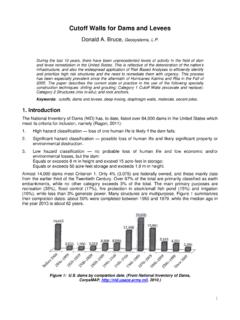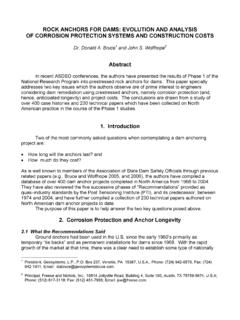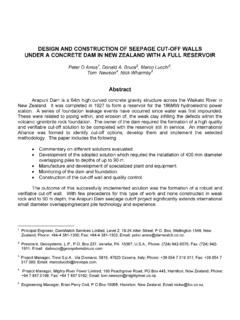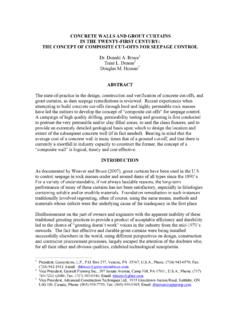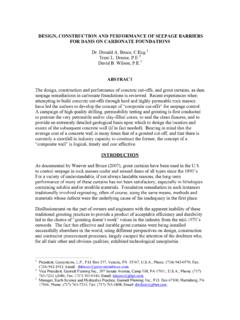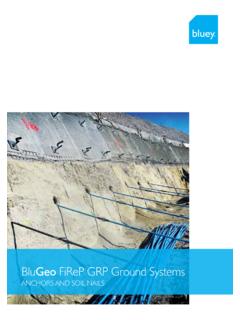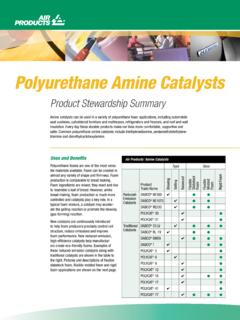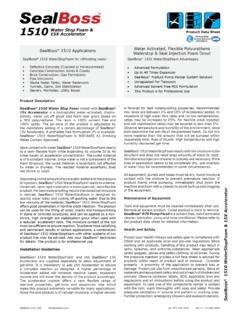Transcription of Seepage Remediation by Positive Cut-Off Walls
1 Seepage Remediation BY Positive Cut-Off Walls : A COMPENDIUM AND ANALYSIS OF NORTH AMERICAN CASE HISTORIES Dr. Donald A. Bruce, President, Geosystems, , Dr. Arturo Ressi di Cervia, Director, Treviicos Corporation, Dr. Jeannine Amos-Venti, Assistant Professor, Merrimack College, ABSTRACT This paper provides, in tabulated and summarized forms, details from a total of 22 North American dams which have been remediated against Seepage and the consequences of Seepage , by using some form of Positive Cut-Off . The purpose of the paper is to provide perspective to potential users of the various techniques in relation to such factors as depth capability, geotechnical suitability, constructability, QA/QC and verification, and cost.
2 The technological scope of the paper is limited to projects involving concrete Walls ( diaphragm Walls ) built by panels or secant piles, soilcrete Walls built by the Deep Mixing Method, and soil-cement Walls . Input is requested from interested readers to expand and modify (as necessary) the information presented herein. The paper assumes a certain level of familiarity with the respective techniques on the part of the reader, and so does not describe their detailed sequential steps of construction. R SUM Cet article pr sente un r sum des donn es provenant de 22 barrages nord-am ricains sur lesquels ont a utilis des parafouilles positifs pour r gler des probl mes de suintement et, par le fait, m me viter ses cons quences n fastes.
3 L article a comme objectif d informer les utilisateurs potentiels de ces divers parafouilles sur la profondeur, l acceptabilit g otechnique, la constructibilit , l assurance et le contr le de la qualit (AQ/CQ), la v rification ainsi que les co ts de ces derniers. La port e technologique de cet article ne s tend qu aux am nagements disposant de murs en b ton ( parois moul es ) construits en palplanche ou en pieux s cants, de murs en b ton projet construits au moyen de la m thode de malaxage en profondeur et de murs sol-ciment.
4 L intervention des lecteurs int ress s d velopper et modifier (si n cessaire) l information pr sent e ici est la bienvenue. Comme cet article tient pour acquis que le lecteur est familier avec les techniques pr sent es, les diff rentes tapes de construction de ces techniques ne seront pas d crites en d tails. 1. SCOPE OF STUDY For over 30 years, major dams in North America have been remediated against the consequences of reservoir leakage by the installation of some form of Positive Cut-Off . Such cut-offs have been successful in eliminating (or greatly minimizing) Seepage through embankments (and dikes) at their contacts with permeable bedrock, and within the bedrock itself.
5 The actual quantity of water lost is, per se, rarely the major issue at hand. Rather, the critical factor is usually the effect of the movement of water in terms of its ability to cause piping and erosion of dam and foundation materials which leads in turn to the potential for causing potentially catastrophic events. The manifestations of such mechanisms are well known: structural movements from minor depressions to major sinkholes; increased flow from drains and wells; disturbing trends from dam and foundation piezometers; and the presence of sediment or embankment materials in springs or Seepage points on or below the dam.
6 Such events may lead to the conclusion that the dam in question has a serious dam safety problem, and/or that a sudden and uncontrolled loss of reservoir may occur unless Remediation is conducted. Major Seepage problems are often recognized as early as first filling of the dam, when they are typically associated with some form of construction (or design) defect in the embankment itself, or at its contact with the rock of the abutments or foundation. On the other hand, it may take much longer tens of years for the problem to manifest itself if the Seepage is causing slow and progressive erosion of foundation material, such as the residual clay infill of heavily karstified terrains.
7 It is also often the case that a truly definitive Remediation measure is not selected often for short-term financial reasons when the decision to remediate is first actually made. For example, the use of drainage ditches, and blankets, berms, or traditional grouting methods in karst, has been found to be only partially and/or temporarily effective, as the situation continues to deteriorate. The authors have long been involved in the design and construction of major remedial cut-offs, both in North America and elsewhere.
8 Such cut-offs require a very high degree of skills and knowledge on the part of the specialty contractors involved: no project is ever completely straightforward, and the majority is anything but. Furthermore, these works are usually conducted in an atmosphere of high anxiety (particularly on the part of the owners) and intensity, and are typically of significant scale. The authors note, however, that the majority of owners and designers contemplating such projects rarely have or have time to acquire an accurate perspective of precedent practice, in general, and of scale and constructability issues in particular.
9 A recent inquiry (quite serious) was received regarding the potential for the installation of a Cut-Off thousands of feet long and 800 feet deep through a dam overlying a soluble and erodible rock foundation. Despite a wealth of historical and technical input from industry specialists throughout the world, the owner clings to the seduction that such a structure is practically feasible and economically viable. This paper presents a summary of data published relating to major North American Seepage remediations.
10 It provides, in tabular form, salient details relating to the nature of the ground and the construction details of particular interest and relevance. A total of 22 case histories are presented: readers are warmly invited to contribute their own information to this database, and to provide information on case histories not covered. The population of case histories divides itself into two lists: The A List case histories with relatively comprehensive published data. The B List case histories about which little or no data have been published or found (so far 8 other projects).
